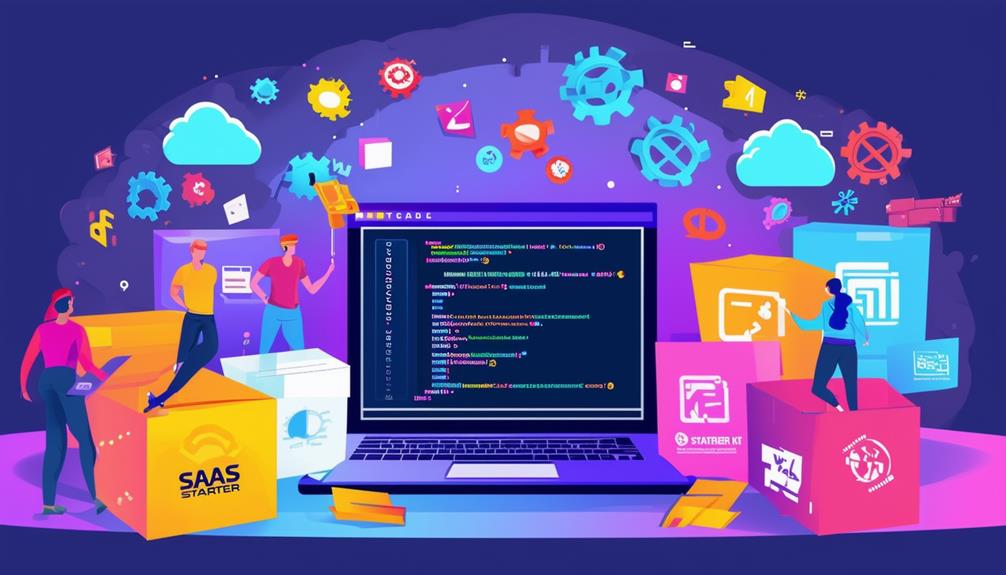When you’re building a SaaS application, choosing the right technology stack can greatly impact your project’s success. You’ve got options like Node.js for its scalability, Ruby on Rails for rapid development, and Django for security features. Front-end frameworks such as React, Angular, and Vue.js can enhance user experience through dynamic interfaces. Each of these technologies brings its own strengths to the table, but which combination will best suit your needs? Understanding their unique advantages is key to making an informed decision. Let’s explore this further.
Node.js
Node.js is a powerful JavaScript runtime that lets you build scalable network applications with ease. By using an event-driven, non-blocking I/O model, it’s particularly well-suited for handling multiple connections simultaneously. You’ll find that its lightweight nature helps you develop faster and more efficiently, allowing you to focus on building features rather than worrying about performance bottlenecks.
One of the standout features of Node.js is its vast ecosystem of libraries and modules available through npm (Node Package Manager). This makes it easy to integrate functionality into your applications without reinventing the wheel. You can quickly add features like authentication, database connectivity, and real-time communication by leveraging existing packages.
Additionally, Node.js works seamlessly with front-end frameworks like React and Angular, creating a smooth development experience across your stack. Its ability to handle JSON natively eliminates the need for additional parsing, streamlining data exchange between your server and clients.
In short, if you’re looking to create high-performance, scalable SaaS applications, Node.js is an excellent choice. Its flexibility and community support make it a top contender for any developer aiming to build modern web solutions.
Ruby on Rails
Ruby on Rails, often simply referred to as Rails, empowers developers to create robust web applications quickly and efficiently with its convention-over-configuration philosophy. This framework simplifies the development process by providing a set of conventions that reduce the need for extensive configuration.
You’ll find that Rails promotes rapid prototyping, allowing you to turn ideas into functional applications in no time.
One of the standout features of Rails is its rich ecosystem of gems, which are libraries that add functionality to your applications. This means you can leverage pre-built solutions for common tasks, saving you time and effort.
Additionally, Rails follows the MVC (Model-View-Controller) architecture, which helps you organize your code effectively and maintain a clear separation of concerns.
Rails also emphasizes testing, making it easy to write and run tests to verify your application works as intended. Its built-in tools help you maintain high code quality and reliability.
With features like scaffolding and migrations, you’ll streamline your development process and adapt to changes swiftly. If you’re looking for a framework that prioritizes speed and developer happiness, Ruby on Rails is an excellent choice for your SaaS boilerplate.
Django
Similar to Ruby on Rails, Django is a powerful web framework that allows you to build scalable and secure applications with ease, leveraging its batteries-included philosophy to streamline your development process.
With Django, you can focus on writing your application logic while it takes care of the heavy lifting, like database management and authentication.
You’ll appreciate Django’s built-in admin interface, which provides an intuitive way to manage your application’s data. This feature can greatly speed up your development time, allowing you to deliver results faster to your clients.
Plus, Django’s ORM lets you interact with your database using Python code, eliminating the need for complex SQL queries.
Django also promotes best practices through its robust architecture, encouraging clean and maintainable code. Its vibrant community contributes a wealth of third-party packages, enabling you to extend your application’s functionality effortlessly.
When it comes to security, Django has got you covered with built-in protection against common threats, such as SQL injection and cross-site scripting.
With these features, you’ll find Django to be an excellent choice for creating SaaS applications that are efficient, secure, and easy to maintain.
Laravel
Laravel is a modern PHP framework that simplifies the development of web applications with its elegant syntax and robust set of features. By using Laravel, you can streamline your development process, allowing you to focus on building exceptional SaaS products. Its built-in tools, like Eloquent ORM for database management and Blade templating engine for dynamic views, make it easy to create and maintain your application’s structure.
You’ll appreciate Laravel’s MVC architecture, which separates your application’s logic from its presentation, leading to cleaner code and better organization. The framework also offers powerful routing capabilities, enabling you to define clean and SEO-friendly URLs effortlessly.
With Laravel’s Artisan command-line tool, you can automate repetitive tasks, saving you time and effort. Additionally, Laravel has an active community that contributes to a rich ecosystem of packages and resources, making it easy to find solutions or enhancements for your app.
Security is another strong point, as Laravel comes with built-in protections against common vulnerabilities, ensuring your application remains secure.
React
React is a powerful JavaScript library that helps you build dynamic user interfaces, making it an excellent choice for developing modern SaaS applications. Its component-based architecture allows you to create reusable UI components, which can greatly speed up your development process. You can easily manage the state of your application using React’s built-in state management system, ensuring a smooth user experience.
When working with React, you’ll find a vibrant ecosystem of libraries and tools that complement it perfectly. For instance, using React Router can streamline navigation within your application, while libraries like Redux enable you to manage complex state interactions effortlessly. Plus, with hooks like `useState` and `useEffect`, you can write more concise and readable code.
Additionally, React’s strong community support means you’ll have access to a wealth of resources, tutorials, and best practices. This makes it easier for you to troubleshoot issues and stay up-to-date with the latest advancements.
If you’re aiming to create a responsive, high-performance SaaS application, leveraging React will certainly enhance your development experience and the quality of your final product.
Angular
Angular is a robust framework that empowers you to build scalable and maintainable web applications, making it an ideal choice for developing SaaS solutions.
With its modular architecture, you can easily manage components and services, promoting code reusability and organization. Angular’s two-way data binding guarantees that your user interface stays in sync with your data model, enhancing user experience.
One of the standout features is Angular’s powerful CLI (Command Line Interface), which simplifies project setup and development tasks. You can generate components, services, and even entire applications with just a few commands. This efficiency allows you to focus more on building features rather than managing configurations.
Additionally, Angular supports TypeScript, providing you with strong typing and modern JavaScript features. This can lead to fewer runtime errors and a more maintainable codebase. With a rich ecosystem of libraries and tools, you can easily extend your application’s capabilities.
Lastly, Angular’s strong community support means you’ll find plenty of resources, tutorials, and third-party tools to help you along the way. Choosing Angular for your SaaS boilerplate can set you on the path to success.
Vue.js
When it comes to building dynamic user interfaces for your SaaS applications, Vue.js stands out with its simplicity and flexibility. This progressive JavaScript framework allows you to incrementally adopt its features, making it perfect for both small projects and large-scale applications.
One of the key advantages of Vue.js is its component-based architecture. You can break down your UI into reusable components, enhancing maintainability and efficiency. Plus, Vue’s reactive data binding system guarantees that your interface updates automatically when your data changes, saving you time and effort.
Vue.js also boasts an extensive ecosystem. With libraries like Vue Router for routing and Vuex for state management, you can easily scale your application while keeping it organized. The documentation is clear and easy to follow, which means you won’t waste time digging through complex resources.
If you’re looking for a framework that combines versatility with ease of use, Vue.js is an excellent choice. It empowers you to create responsive applications that provide an engaging user experience, all while keeping development straightforward.
Give Vue.js a try, and see how it can elevate your SaaS projects!
To Wrap Up
In choosing the right technology for your SaaS boilerplate, consider your project’s specific needs and your team’s expertise.
Whether you lean towards Node.js for scalability, Ruby on Rails for rapid development, or a front-end framework like React or Vue.js for a dynamic user experience, each option brings unique strengths to the table.
By leveraging these popular technologies, you can streamline your development process, ensuring a robust and efficient application that meets user demands effectively.






